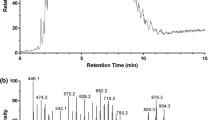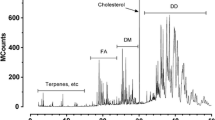Abstract
A sulfur-containing compound causes the foul smell of the defensive pygidial gland fluid of Ceroglossus buqueti Laporte and Ceroglossus magellanicus Gehin. This compound was identified as 3-methyl-1-(methylthio)-2-butene by a comparison of its mass spectrum, and chromatographic properties with those of a chemically synthesized standard. Although a few sulfur compounds are known from insect secretions, this sulfur-bearing isoprene derivative has not been characterized previously from any arthropod source. Additional components in the defensive section include acetic, propanoic, isobutyric, butanoic, methacrylic, ethacrylic, tiglic and benzoic acids, and 11-tricosene. Samples prepared from specimens of Ceroglossus chilensis Eschscholtz showed methacrylic, ethacrylic, and other acids. However, 3-methyl-1-(methylthio)-2-butene was not detected in the defensive fluid of C. chilensis.




Similar content being viewed by others
References
Andersen K, Bernstein DT (1975) Some chemical constituents of the scent of the striped skunk (Memphitis memphitis). J Chem Ecol 1:493–499
Attygalle AB (1998) Microchemical techniques. In: Millar J, Haynes K (eds) Methods in chemical ecology. Chapman and Hall, London, pp 207–281
Attygalle AB, Morgan ED (1984) Chemicals from the glands of ants. Chem Soc Reviews 13:245–278
Attygalle AB, Meinwald J, Eisner T (1991) Biosynthesis of methacrylic and isobutyric acids in a carabid beetle, Scarites subterraneus. Tetrahedron Lett 32:4489–4852
Attygalle AB, Wu X, Ruzicka J, Rao S, Garcia S, Herath K, Meinwald J, Maddison D, Will KW (2004) Defensive Chemicals of two species of Trachypachus motschulski (Coleoptera: Trachypachidae). J Chem Ecol 30:577–588
Attygalle AB, Wu X, Will KW (2007) Biosynthesis of tiglic, ethacrylic, and 2-methylbutyric acids in a carabid beetle, Pterostichus (Hypherpes) californicus. J Chem Ecol 33:963–970
Benítez H, Briones R, Viviane JV (2011) Intra and inter-population morphological variation of shape and size of the Chilean magnificent beetle, Ceroglossus Chilensis in the Baker river basin, Chilean Patagonia. J Insect Sci 11:94–103
Benn MH, Lencucha A, Maxie S, Telang SA (1973) The pygidial defensive secretion of Carabus taedatus (Col. Carabidae). J Insect Physiol 19:2173–2176
Block E, Zhuang H (2013) Smelling sulfur: discovery of a sulfur-sensing olfactory receptor that requires copper. In: Biochalcogen chemistry: the biological chemistry of sulfur, selenium, and tellurium; ACS Symposium Series; American Chemical Society: Washington, DC, 1152, pp 1–14
Blum MS (1981) Chemical defenses of arthropods. Academic Press, New York
Bousquet Y (2012) Catalogue of Geadephaga (Coleoptera, Adephaga) of America, North of Mexico. ZooKeys 245:1–1722
Butovsky RO (1992) Sulfur compounds and entomofauna. Agrokhimiya (1):159–168
Byers JA (2015) Earwigs (Labidura riparia) mimic rotting-fresh odor to deceive vertebrate predators. Naturwissenschaften 102:1–10
Casnati G, Ricca A, Pavan M (1967) Defensive secretion of the mandibular glands of Paltothyreus tarsatus. Chim Ind (Milan, Italy) 49:57–58
Das S, Das S, Sherpa MT, Thakur N (2018) Is sulfur compounds are hidden chemoattractant for insects? Exp Find 25:4. https://doi.org/10.13140/rg.2.2.36581.86243
Dazzini-Valcurone M, Pavan M (1980) Glandole Pigidiali e Secrezioni Difensive Dei Carabidae (Insecta Coleoptera). Pubblicazioni Dell’Istituto Di Entomologia Dell’Universita Di Pavia 12:1–36
Dettner K (1985) Ecological and phylogenetic significance of defensive compounds from pygidial glands of Hydradephaga (Coleoptera). Proc Acad Natl Sci Phil 137:156–171
Dettner K (1987) Chemosystematics and evolution of beetle chemical defenses. Ann Rev Entomol 32:17–48
Dettner K (1990) Chemische Abwehr bei der ursprunglichen Käferfamilie der Amphizoidae—ein Beitrag zur Evolution der Pygidialdruse der Hydradephaga. Mitteilungen der Deutschen Gesellschaft fuer Allgemeine und Angewandte Entomologie 7:519–526
Eisner T, Swithenbank C, Meinwald J (1963) Defense mechanisms of arthropods. VIII. Secretion of salicylaldehyde by a carabid beetle. Ann Entomol Soc Am 56:37–41
Frank ET, Schmitt T, Hovestadt T, Mitesser O, Stiegler J, Linsenmair KE (2017) Saving the injured: Rescue behavior in the termite-hunting ant Megaponera analis. Sci Adv 3:e1602187
Giglio A, Brandmayr P, Dalpozzo R, Sindona G, Tagarelli A, Talarico F, Brandmayr TZ, Ferrero E (2009) The defensive secretion of Carabus lefebvrei Dejean 1826 pupa (Coleoptera, Carabidae): gland ultrastructure and chemical identification. Microsc Res Tech 72:351–361
Ishikawa Y (1983) Insects and secondary compounds of plants. Kagaku to Seibutsu 21:594–601
Jiroux E (1996) Revision du genre Ceroglossus. Collection Systematique, vol 1. Magellanes, Ver-neuil-sur-Seine
Jiroux E (2006) Le genre Ceroglossus. Collection Systematique, vol 14. Magellanes, Verneuil-sur-Seine
Kanehisa K, Kawazu K (1982) Fatty acid components of the defensive substances in acid-secreting carabid beetles. Appl Ent Zool 17:460–466
Keegans SJ, Billen J, Morgan ED, Gokcen OA (1993) Volatile glandular secretions of three species of new world army ants, Labidus coecus, and Labidus praedator. J Chem Ecol 19:2705–2719
Lecic S, Curcic S, Vujisic L, Curcic B, Curci N, Nikolic Z, Andelkovic B, Milosavljevic S, Teševic V, Makarov S (2014) Defensive secretions in three ground-beetle species (Insecta: Coleoptera: Carabidae). Ann Zool Fennici 51:285–300
Longhurst C, Baker R, Howse PE (1979) Termite predation by Megaponera foetens (Fab.) (Hymenoptera: Formicidae). Coordination of raids by glandular secretions. J Chem Ecol 5:703–719
Meinwald J, Eisner T (1995) The chemistry of phyletic dominance. In: Meinwald J, Eisner T (eds) Chemical ecology: the chemistry of biotic interaction. National Academy Press, Washington, D.C., pp 29–40
Michelot D, Linstrumelle G, Julia S (1977) Synthesis of 2,5,5-trimethylhepta-2,6-dien-4-one (artemisia ketone). I. Using a rearrangement of an intermediate sulfonium ylide. Syn Commun 7:95–102
Moir M, Gallacher IM, Seaton JC, Suggett A (1980) Terpene methyl sulfides in the essential oil of hops. Chem Ind (London, UK) 15:624–625
Moore BP, Brown WV (1979) Chemical composition of the defensive secretion in Dyschirius Bonelli (Coleoptera: Carabidae: Scaritinae) and its taxonomic significance. J Austr Entomol Soc 18:123–125
Moore BP, Wallbank BE (1968) Chemical composition of the defensive secretion in carabid beetles and its importance as a taxonomic character. Proc R Ent Soc Lond (B) 37:62–72
Morgan ED (2004) Biosynthesis in Insects. RSC Publishing, Cambridge
Muñoz-Ramírez C (2015) The phylogenetic position of Ceroglossus Ochsenii Germain and Ceroglossus Guerini Germain (Coleoptera: Carabidae), two endemic ground beetles from the Valdivian forest of Chile. Revista Chilena de Entomología 40:14–21
Okamoto M, Kashiwai N, Su ZH, Osawa S (2001) Sympatric convergence of the color pattern in the Chilean Ceroglossus ground beetles inferred from sequence comparisons of the mitochondrial ND5 gene. J Mol Evolut 53:530–538
Oswald AA, Griesbaum K, Thaler WA, Hudson BE Jr (1962) Organic sulfur compounds. VIII. Addition of thiols to conjugated diolefins. J Am Chem Soc 84:3897–3904
Prüser F, Mossakowski D (1998) Conflicts in phylogenetic relationships and dispersal history of the supertribe Carabitae (Coleoptera: Carabidae). In: Ball GE, Casale A, Vigna Taglianti A (eds) Phylogeny and classification of Caraboidea (Coleoptera: Adephaga). Proceedings of a symposium (28 August, 1996, Florence, Italy) XX International Congress of Entomology. Museo Regionale di Scienze Naturali, Torino. p 543
Rizzi GP (1995) Formation of sulfur-containing flavor compounds from allylic alcohol precursors. Dev Food Sci 37A:289–302
Roussel Uclaf SA (1966) Cyclic sulfones. Patent NL 6508580
Seaton JC, Suggett A, Moir M (1981) The flavor contribution of sulfur compounds in hops. Tech Q Master Brewers Assoc Am 18:26–30
Šiaučiulis M, Sapmaz S, Pulis AP, Procter DJ (2018) Dual vicinal functionalisation of heterocycles via an interrupted Pummerer coupling/[3,3]-sigmatropic rearrangement cascade. Chem Sci 9:754–759
Su Z-H, Imura Y, Okamoto M, Osawa S (2004) Pattern of phylogenetic diversification of the Cychrini ground beetles in the world as deduced mainly from sequence comparisons of the mitochondrial genes. Gene 326:43–57
Thibout E, Lecomte C, Auger J (1996) Sulfur substances in Allium and insects. Acta Botanica Gallica 143:137–142
Verts BJ (1967) The biology of the striped skunk. University of Illinois Press, Urbana
Waterhouse DF, Wallbank BE (1967) 2-Methylene butanal and related compounds in the defensive scent of Platyzosteria cockroaches. J Insect Physiol 13:1657–1669
Will KW (2000) Systematics and zoogeography of Abaryform genera (Coleoptera: Carabidae: Pterostichini), and a phylogenetic hypothesis for pterostichine genera. PhD dissertation. Cornell University, Ithaca, New York, p 289
Will KW, Attygalle AB, Herath K (2000) New defensive chemical data for ground beetles (Coleoptera: Carabidae): Interpretations in a phylogenetic framework. Biol J Linn Soc 71:459–481
Wood WF (1990) New components in defensive secretion of the striped skunk, Mephitis mephitis. J Chem Ecol 16:2057–2065
Zhang J-X, Sun L, Zhang Z-B, Wang Z-W, Chen Y, Wang R (2002) Volatile compounds in anal glands of Siberian weasels (Mustela sibirica) and Steppe polecats (M. eversmanni). J Chem Ecol 28:1287–1297
Acknowledgements
We thank Pablo Wagner from Flor del Lago for his assistance with Ceroglossus specimen collections. We acknowledge financial support from the Natural Science Foundation (NSF) Grants 1556898 (ABA) and 1556957 (KW).
Author information
Authors and Affiliations
Corresponding author
Additional information
Communicated by Günther Raspotnig.
Electronic supplementary material
Below is the link to the electronic supplementary material.
Rights and permissions
About this article
Cite this article
Xu, S., Errabeli, R., Will, K. et al. 3-Methyl-1-(methylthio)-2-butene: a component in the foul-smelling defensive secretion of two Ceroglossus species (Coleoptera: Carabidae). Chemoecology 29, 171–178 (2019). https://doi.org/10.1007/s00049-019-00286-0
Received:
Accepted:
Published:
Issue Date:
DOI: https://doi.org/10.1007/s00049-019-00286-0




